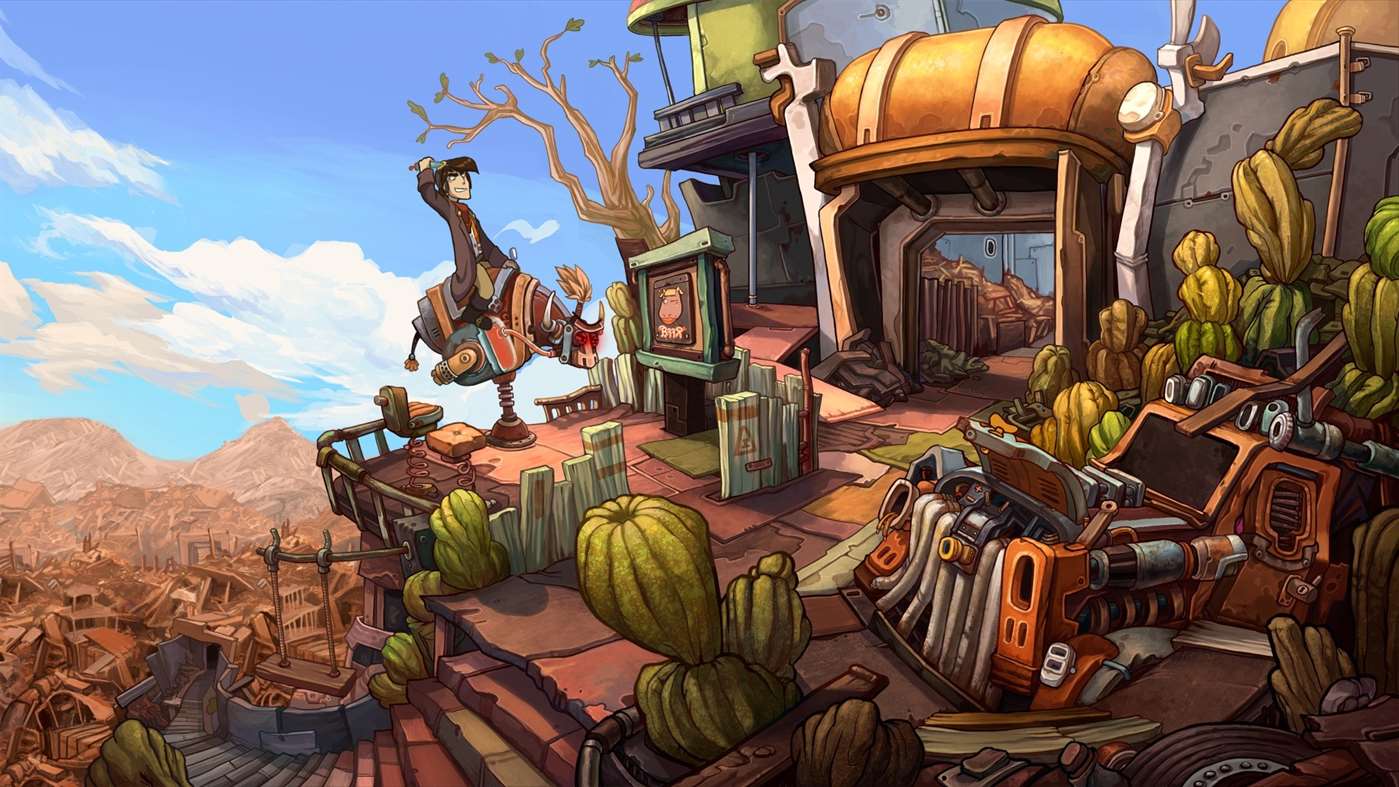The Deponia series had always been a point-and-click saga that eluded gamers who prefer the Microsoft brand of consoles, with only a solitary title reaching the Xbox One catalogue in recent years – the second instalment, Chaos on Deponia, oddly. Daedalic Entertainment, the developers and publishers behind these adventures, have decided to bundle the entire series together as the Deponia Collection for a release across all the major console platforms. Was it worth the wait to get the whole story at once, or will possessing the complete collection of four games feel somewhat like overkill?
First, let’s assess what you’re getting here: the Deponia Collection includes Deponia, Chaos on Deponia, Goodbye Deponia, and Deponia Doomsday. That’s four point-and-click adventures at a discounted price, compared to buying them separately, which gets a big thumbs up for starters. But what’s it about exactly? Who’s the hero of this mammoth tale you’re about to embark upon?

Did I say hero? Perhaps ‘main protagonist’ is more appropriate for the star of the Deponia Collection, Rufus, who is very much just a no-hoper with a big dream – and he doesn’t care how he goes about achieving it either. Living on the junkyard-esque planet of Deponia, Rufus wants to leave it all behind and travel to a floating utopia known as Elysium. It soon becomes apparent that his attempts at leaving Deponia are often the talk of the town, with everyone seemingly writing him off as a waste of space. But one day, he accidently knocks out a beautiful Elysium woman, Goal, during a botched rescue job in the middle of failed flight.
The original three offerings in the series follow Rufus’ efforts to help Goal regain her normal functions, while convincing her that he means well and that the dreaded Organon, a militant organisation from whom he saves her from, are up to no good. Daedalic initially planned for a trilogy you see, so these three games stretch out that narrative across many, many hours – and it is a bit of a stretch. What the final instalment, Deponia Doomsday, does is provide an alternate scenario of the happenings that injects a whole load of sci-fi antics into proceedings, involving time travel and a weird species of creatures known as Fewlocks. There’s no doubt you’ll be very welcoming of this last hurrah.
The cutscenes, although often exciting, aren’t used regularly enough as a tool to further the story, so instead you’re more likely to unravel the tale through the dialogue, which is brilliantly voiced to ensure the characters feel unique. As a result, there are a lot of quirky and interesting characters for Rufus to interact with along the way. Aside from the ever-present Goal, there’s the no-nonsense former girlfriend Toni who frequently rips him to shreds verbally; an old chap, Doc, who is a dab hand at fixing stuff; Gizmo who multi-tasks as the town’s fireman, doctor and policeman; and McChronicle, an expert in the field of temporal physics.

And that’s barely scratching the surface, with sneaky resistance members, Organon officers, a ‘ghost’ with a fetish for people singing in the shower and even Rufus’ irresponsible father all coming together to help keep the tale from going stale. Humour is at the core of the entire experience – usually at the expense of our bumbling protagonist – with most of it being low-brow and silly, but the eccentric personalities are just as important in keeping you interest.
When it comes down to gameplay, it’s essentially your typical point-and-click experience, seeing you move Rufus around 2.5D environments to interact with everything and anything. Items can be picked up to put in an inventory, looked at more closely, used with an object or person within an area, and combined with each other to make some fancy thingamajigs. Cycling through the many points of interaction nearby is easy enough to do, with either of the bumpers doing the job nicely. It reminds me of The Inner World series in the way it handles, as well as in regards the mostly seamless transitions between places.
Don’t expect a walk in the park though, with many of the problems you’ll help Rufus overcome not solved easily. Even something as simple as making a coffee or fashioning a weapon is convoluted; sending you back and forth through various locations to obtain the most obscure ingredients/parts that you wouldn’t usually expect to need. And whilst the ideas implemented lead to ingenious uses of junk, the thought process required for succeeding is so out of the box that there will be moments where you’ll be begging for a hint. It’s fortunate that more often than not, asking NPCs will provide a bit of direction, but only after a hefty amount of dialogue and aimless wandering.
It has to be said that, in light of the challenging problems, eventually solving them does feel rather glorious – even more so when you’ve spent upwards of an hour working on the necessary components. There’s a section in Chaos on Deponia where a quartet of platypus eggs must be found, acquired and hatched. Despite feeling drawn out at times, the sheer relief and joy after accomplishing such things is so worth it.

In an attempt to break up the constant inventory based puzzles, there are mini-games to get involved with and across the four games they really do evolve nicely. Some of the highlights involve a noughts and crosses game with interference by a rat, changing pipe fittings to alter the course of an egg running through them, mirroring the actions of someone brushing their teeth, and a spot of golf. There are lowlights that’ll have you scratching your head, however the option to skip is a welcome one should you need it.
Given that Deponia Collection features four titles set in the same universe, it’s difficult to avoid repetition of characters and locations, especially when spending a large chunk of time the town of Kuvaq. Daedalic do a terrific job though, creating a run-down world full of junk that’s still appeasing on the eyes, which is important when traversing through these places time and time again. Another place that stands out is the idyllic Elysium, which really shines in the final instalment, even when it’s looking a bit in disarray. As for the characters, there are so many memorable folk in fitting attire that credit must be given for the varied designs.
Surprisingly, for the amount of hours you can spend in this world, there are barely any noticeable bugs. Unfortunately, those that do occur are a real pain in the backside, with one hitting my experience immediately. Upon loading up Deponia, it automatically set the language to a made up one that changes every word of dialogue to ‘droggeljug’ – extremely confusing for someone new to the series. Another issue occurred by interacting with an item ahead of when it’s supposed to happen, effectively forcing a load of an earlier save as it prevented any progression being possible.

Deponia Collection on Xbox One brings four point-and-click adventures that are chock full of old school inventory-based puzzles to solve. They are terribly difficult, sometimes to the point where the impatient gamers may give up, but the frustration is off-set by the humorous goings on involving the hapless Rufus and the increasingly creative mini-games. It’s great to see the evolution of the series from Deponia to Deponia Doomsday too, with the latter being arguably the best of the pack and the wackiest by far.
This selection of games will keep you going for hours and hours, so if the challenging nature doesn’t put you off and you don’t mind a load of dialogue, there’s plenty of value in Deponia Collection.







